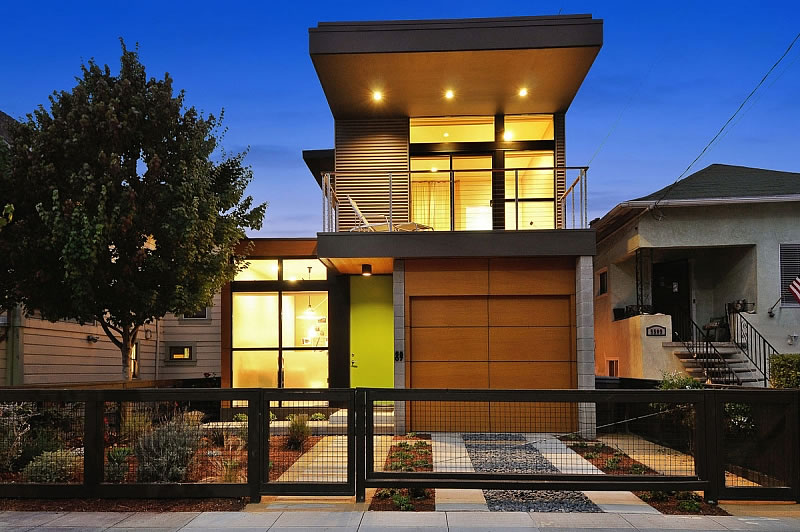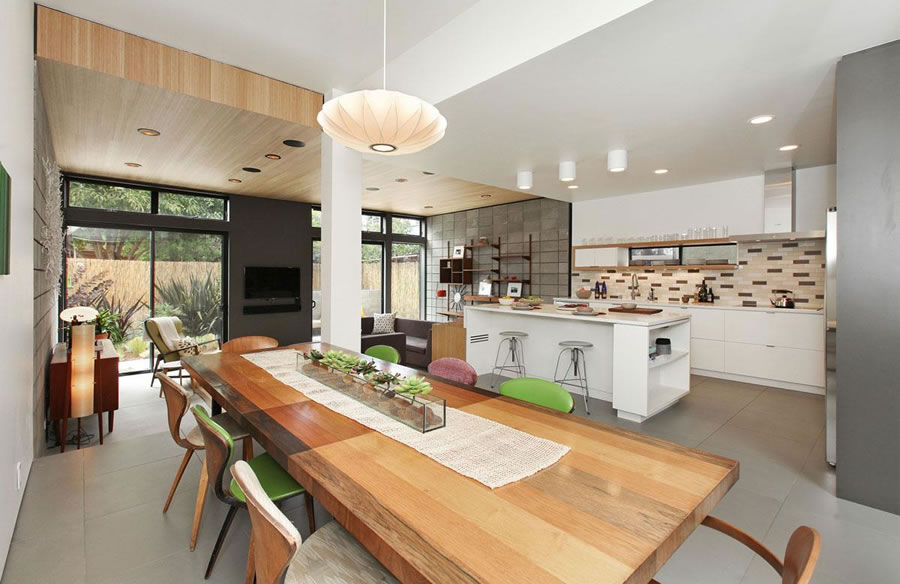While the garage and ground floor of the modern Emeryville house at 5507 Beaudry Street were built in place, the rest of the home was prefabricated in five sections down in San Jose and assembled on site in a day back in 2011.
Measuring 2,083 square feet, the prototype “Simpatico” house was designed by Swatt | Miers Architects to be a net-zero energy building, with energy efficient fixtures and appliances throughout, a 6.2 kw rooftop solar panel array atop to power the all electric home, and walls of dual pane glass for light and passive solar heating.
And while Simpatico Homes is no longer in business, the founder’s prefabulous prototype at 5507 Beaudry is now on the market and listed for $1,050,000, or just over $500 per square foot.



Seems like if half the house is site-built and the other half comes on a truck, you’ve got all of the challenges of both construction methods but many fewer synergies. No es muy simpatico para mi dinero. Also muy confundido para los building inspectors. Quienes son muy pains in the rear-o about this sort of thing.
I like the Swatt Miers design and here at least we have a project that defines itself purposefully as a box, like for shoes.
With prefab modular, you’ll always have foundation and similar work to do anyway – there’s always some element of ‘traditional’ construction. But look at it this way – after spending undoubted weeks doing the slab and first floor, the 2nd floor was added in one day. Still sounds like a winner to me.
Have you built many houses this way (1/2 site built and 1/2 prefabricated)?
How do the costs work out?
This is nothing.
Expect custom 3D printed homes to crush construction costs in the near future.
Factor in the rise of general purpose robotics that can now ‘watch and learn’ any activity, work 24hrs with no breaks, fatigue, ‘human errors’ and can download the latest specs/regulations instantly so everything is to code.
And we will be seeing a whole new world of home ownership, well for those who won’t be losing their jobs to 3D printing and robotics.
oh and for those who think automation and robotics will not be taking your job (because you are a ‘creative’ or highly skilled professional’).
I recommend you watch this 15 minute video on why that isn’t true: Humans Need Not Apply
I am still holding off on purchasing a Honda Civic this year because of all of the hovercrafts coming out next spring.
well if you’re waiting for a hover car keep waiting.
But driverless cars and trucks are here, now.
Say goodbye to most trucker driver, taxi, and car service jobs.
Uber is worth $10 Billion? Not once driverless, wifi enabled, cars become mainstream.
Lyft and Halo, they will survive for a while but these services are going to be short lived unless they decide to invest millions in their own fleets (which goes directly against their business models)
Your beautiful Victorian home is worth Millons? Not once I can 3D print the same home with the same details in all the same ‘painted lady’ colors for a fraction of the cost and have it assembled for me in a fraction of the time it would take human workers to do it.
Will people pay a premium for the SF location? Sure. But no one is going to care about that +100 rotting piece of wood sitting on the lot that needs hundreds of thousands in upgrades and maintenance.
If you think this is some far of future you should do a little digging. These things are here, now and it’s only going to become more disruptive.
SOON THERE WILL BE ROBOTS WHO CAN EAT NACHOS FOR ME SO I DON’T HAVE TO.
WHAT WILL HAPPEN THEN!?!?!?!?!?!?
WHAT WILL BECOME OF THE NACHO INDUSTRY?
IT SOUNDS, (IRONICALLY) LIKE IT IS NACHO PROBLEM IF YOU ARE IN THE NACHO INDUSTRY!!!
Today.
“Self-Drive Cadillac: New Smart Car Technology To Deliver One By 2017“
I am sure many people will line up for a self-driving Cadillac at the first offering.
Why wouldn’t someone want to pick up a car like that from General Motors, whose standard Cobalt sedans accidentally shut themselves off in the middle of intersections?
There is absolutely a place for modular construction, but this Simpatico house didn’t have it figured out, and I remain thoroughly dubious that 3D printing of houses is realistic in the next 50 years.
Producing modular buildings in an enclosed factory environment, shipping them to the site and bolting them together makes sense. Construction can be more precise and save money with replication. Would like to see more of those.
Michelle Kaufman’s Glidehouse was a neat design that also never got traction. BluHomes offers a number of cool options.
All of these innovators face challenges and the resistance to changing the status quo. It takes a really long time for people to accept these changes.
SM, you need to get a ground effect Hovercraft — cuts commute times to the South Bay (or soccer field) in half. Imagine the impact you’d make landing one of these in the middle of a practice session. I’m thinking about getting one and becoming an Uber driver. I figure its a while before the robots can handle low flying navigation over water.
So who is going to have the money to buy these fancuy houses, given that we will all be unemployable?
3D printed homes are a real thing right now. A single 3D printer can ‘print’ ten houses a day.
The robots/autos featured in the ‘Humans Need Not Apply’ video are all real and currently in use.
snicker all you want but 3D printing and robotics are going to be so disruptive to the global economy it is hard to even wrap your head around it.
Thanks for the link to Humans Need Not Apply, really great stuff. I’ve been haunted by these questions in recent years. Not that the video has any answers, but I’m glad it helps wake people up to paying some closer attention to what’s happening.
This technology will radically affect the market for single room cast concrete homes without plumbing or electricity throughout the bay area.
ROFLOL. They laughed at the Model T. Now we have TESLAS that lock their doors and refuse to let you out…when they are not catching on fire. 🙂
Whether built by robots or human beings, how do people feel about the price given the location. Finishes and design look nice for what it is. Personally, I’d probably feel okay about investing in that neighborhood, but maybe not living there with my family.